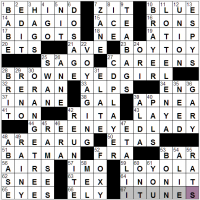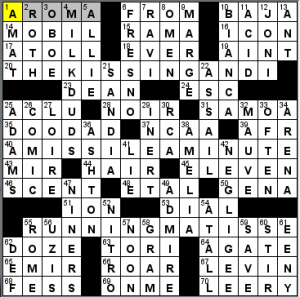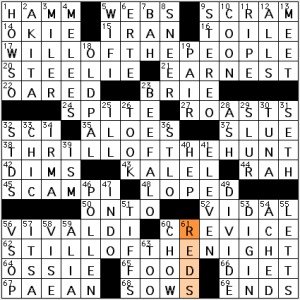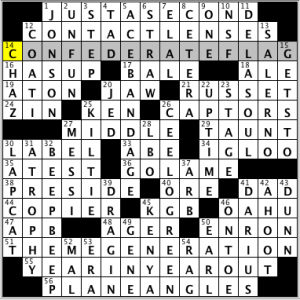NYT 4:03 (pannonica)
LAT 2:39
CS 5:40 (Sam)
BEQ 5:05
Peter A. Collins’ New York Times crossword — pannonica’s review
Interesting arrangement of the theme entries in this puzzle. Two are intact and appear in conventional locations. The third is divided into its constituent words and fills three of the four across corners; the fourth position (67a) is occupied by the revealer [Where to find the songs in this grid … or an appropriate title for this puzzle?] ITUNES.
- 1a. [With 10- and 65-Across, 1971 hit by The Who] BEHIND | BLUE | EYES.
- 28a. [1967 hit by Van Morrison] BROWN-EYED GIRL.
- 44a. [1970 hit by Sugarloaf] GREEN-EYED LADY.
Not being an acolyte, I don’t know if all three are in fact available on iTunes, but I’ll assume they are. Aside from the the revealer making the occasion feel a bit like an advertisement, the only criticism I can lay on the theme is that The Who song’s title lacks the “color-‘eyed’-noun” structure of the other two. Less important, the title refers to a man rather than a woman, as 28a and 44a do. Perhaps one of the those entries should have been replaced with another song, to further vary matters?
Anyone else distracted by the prominent ZIT found between BEHIND and BLUE? Having a three-letter word there is a necessary artifact, but I would have been happier, and less distracted by imagery, if the answer had nothing to do with marring a face (with blue eyes). ELY, down on the bottom at 66a, doesn’t have the same effect.
The fragmented nature of that themer allows the puzzle to contain more interesting long fill than a typical 15×15 grid, so we are treated to LOTTE LENYA, CD PLAYER, VOYAGING, and ORANGE TREE, though for that last entry it strikes me that colors should not have appeared in the ballast fill, so as to avoid distraction.
Notes:
- 27a [Turns at high speed] CAREENS. The word has no turning requirement. Less critically, BIGOTS needn’t be [Haters], just people who hold strong opinions and prejudices.
- A couple of ambiguous tense clues caused me to lose some time in the solving process: In 32a [Broadcast again] I took it to be the present-tense RERUN instead of RERAN, whereas in 42d I wanted [What the Beatles never did] to be the past participle REUNITED rather than REUNITE. Should the “the” in that clue have been capitalized?
- XWord Info shows that Gregory E. Paul’s Monday NYT puzzle of 20 March 2000 also used BROWN-EYED GIRL and GREEN-EYED LADY, with the non-song BLACK-EYED SUSANS the 15-letter spanner in the work. The curse of the ⅔ theme strikes again!
- BOYTOY and BATMAN as a symmetrical pair, hmm.
Hazel always gets ignored.
Doug Peterson’s CrosSynergy/Washington Post crossword, “Taking Issue” – Sam Donaldson’s review
Doug’s addition has certainly improved the publication rate of Team Fiend members! He’s back today with a fun take on the “add-a-letter” theme, this time adding ISS to three common expressions to make them all wacky and such. See for yourself:
- 20-Across: THE KISSING AND I (playing off The King and I) would be an apt title for [Casanova’s memoir?]. If it were the title of my memoirs about my teen years, alas, it would be The One Kiss and I.
- 40-Across: One way to describe a [Slow dart player’s pace?] is A MISSILE A MINUTE, playing off “a mile a minute.” That’s a fun and lively clue.
- 55-Across: Add ISS to RUNNING MATE and you get a RUNNING MATISSE, or the [“Woman with a Hat” painter out for a jog?].
All three theme entries are solid, and with long Down like MILK DUDS and NEGLIGEE, well, there’s lots to ADMIRE ([Think highly of]). I especially liked the modern clue for ASHTON, [Charlie’s “Two and a Half Men” replacement]. Too soon to base the clue on his marital problems?
There was an unusually high amount of stuff that was new to me. I needed every single cross to fill in the blank for [New Mexico’s ___ Mountains], because SANDIA is one mountain range I’ve never heard of before. I also did not know BIANCA was [Kate’s sister in “The Taming of the Shrew”], as I’m not very familiar with the play, obviously. AMELIA, to me, is an island in Florida. But it’s also the given name of [Suffragist Blooner]. Now [Kate’s sitcom housemate], however, was a gimme. Why’s it’s ALLIE, from Kate & Allie.
Donna Levin’s Los Angeles Times crossword
Are you sick of themes like this? are just totally ILL OF THEm? Donna groups three familiar phrases that take the form “*ILL OF THE [something],” all 15 letters long:
- 17a. [National consensus] is the WILL OF THE PEOPLE.
- 38a. [Deerstalker’s excitement] is the THRILL OF THE HUNT.
- 62a. [Dark, quiet period] is the STILL OF THE NIGHT.
Now, Donna could have opted to include more long answers in the fill, cutting the word count. That could spice things up, but it probably would have entailed more compromises in the fill. And what Monday puzzles are about is No Compromises in the Fill: no obscure crosswordese or awkward abbreviations that newer solvers might never have had cause to encounter. (One of these days I’m going to ask where the OLEO is at a supermarket, just to see if the people who sell margarine have any clue that “oleo” is a less common word for the spread.)
Five words most likely to stymie newbies (but much less obscure than some other common crossword answers):
- 20a. [Metal playing marble] is a STEELIE. Kids had pretty much stopped playing the official game of marbles by the time I came around. Other crosswordese marbles include TAW, AGATE, and, rarely, IMMIE. Luckily, TAW can also be clued by way of Tweety Bird.
- 37a. To SLUE is to [Turn on a pivot]. I feel I pretty much never encounter this word outside of crosswords.
- 6d. [One-named Deco artist] ERTÉ is pronounced “air-tay,” or how the initials “R.T.” are pronounced in French. His real name is Romain de Tirtoff. A Google image search for erte will show you his work. Art Deco decoration, fashion, cool stuff.
- 36d. [WWII Normandy battle site] is ST. LO in France. Warning! There was also a Battle for Caen during the Battle of Normandy, and both STLO and CAEN have 4 letters. You need to fill in one of the crossing words to know which French town will work.
- 55d. [Riga natives] are Latvians or, in crosswordese, LETTS. Okay, that right there is a fairly big Compromise in the Fill. The crossing answers are straightforward, though if you don’t know that [Hairdresser Sassoon]’s first name is VIDAL, you would be a total and complete loss for that L in LETTS. Ideally, unfamiliar proper nouns never cross other proper nouns that aren’t wildly familiar (e.g. [Actor Brad of “Babel”] should take everyone to PITT without any trouble, so that would be an entirely fair crossing). I’m not sure where VIDAL fits on the scale between Brad Pitt and LETTS.
Solid three stars.
P.S. Typo in the clues: 61d: [Cinncinati team], the REDS, should be Cincinnati. “Cin” x 2, + “nati.”
Brendan Quigley’s blog crossword, “Themeless Monday”
I’m pretty sure that if The Dukes of Hazzard were remade today, the CONFEDERATE FLAG would be banished from the General Lee. Knowing what I know now, man, that would be a reason not to watch the show. Ah, the late ’70s were a different era, where plenty of country songs crossed over to top 40 and plenty of good ol’ boys headlined TV series. I bet DARIUS Rucker doesn’t have that fondness for the Confederate flag.
Toughest squares for me: Didn’t know 20d: [Infielder Lowrie] and contemplated NED and TED (though nobody excavates slangy negatives or crosswordese marbles). Finally ran the alphabet and hit JED and a fossil JAW. The two 3-letter sports crossings for the mystery geometry term PLANE ANGLES also stymied me. RAG in hockey, ERA in…I don’t know what sport [Live-ball __] ERA pertains to.
51a is the crossword constructor’s first step, unless it’s Themeless Monday.
Really liked JUST A SECOND and YEAR IN, YEAR OUT. Plus the lovely Mr. CEE-LO GREEN. Oh! And BEEP, BEEP. Didn’t know there was such a thing as a LAP CAT. Is that in the language? Not sure if check kiting pertains to NSF, really.
3.5 stars.




Read iTunes as Eye Tunes…
I thought that part was obvious.
Just thought that reading might dispense with the horse blinders!
CROSS-EYED MARY would have made a nice center entry.
Or ONE-EYED ONE-HORNED FLYING PURPLE PEOPLE EATER.
I really must remember these two bits of crosswordese: SEGO lily and SAGO palm. They trip me up every time.
“Should the ‘the’ in that clue have been capitalized?”
No. Check a reliable style guide, such as the Chicago Manual of Stye (see http://www.chicagomanualofstyle.org/CMS_FAQ/CapitalizationTitles/CapitalizationTitles52.html ), which specifies that “the” in front of a band name in running text is not capitalized, even in “the The”.
Just wondering how the The would work in a Sporcle quiz. Enter a blank?
Ended with BABy/yTS. Couldn’t find that error. Shrug.
Pannonica: Sorry, we were having a conversation in the other thread that got lost in the shuffle. I’d be happy to hear from others on this as well. Pannonica had mentioned in her review that a number of three-letter partials, including REM, CAL, and EVA, were weak, and that a certain puzzle corner “suffered a lot” from having them all in the same area. What I was curious about is what the problem is with those words? REM is a pretty famous band – even I know them! CAL is not only the name of some very famous people, but also doubles as the widely-known and commonly-used nickname of a noted American university. EVA can refer to a variety of women, past and present, who almost any solver will recognize. What, then, makes these entries so weak? I believe you that they are, since you are obviously a critic with high standards who would never nitpick just to be snarky or because you decide to take advantage of the position you are in, like small people invested with power throughout history have done, often as compensation for their personal inadequacies. I am a great fan of your reviews and well understand you would not stoop to that level.
The reason I’m asking is because I’m trying to understand as specifically as possible what kind of criteria we use to judge the goodness or badness of entries. What standards do we apply? What specific questions can be asked? I know the usual suspects – partials, unfamiliarities, crosswordese. But I don’t see which of these apply to CAL, EVA, and REM. Looking forward to being enlightened. Thank you.
Finally! A “hard” BEQ that wasn’t too full of names outside my KEN! Made my Monday, though I still don’t know who MESSI is?
I didn’t much like “broadcast” as the past tense either. But, even according to what certain nameless others see as my stodgy, uncool, outdated reference of choice in these matters – the unabridged OED – “broadcast” is the more common past tense as well as past participle! “Broadcasted” merely merits an “occasionally”.
MD Solver: My feeling is that if a constructor is going to resort to a triple (or greater) three-letter stack, the words should be more interesting, or less obscure. Especially if said stack occupies a prominent position, such as the top left corner, the most common starting location. In that Thursday Tausig, I felt that CAL, RDA, ULU and KAN, EVA, REM were rather ungainly groupings. Perhaps I was a little too glib in my assessment that the interesting long crossing fill that necessitated them caused the puzzle to “suffer a lot.”
Drive-by Commenter: Thanks! I didn’t know that CMOS had any of its content available on-line.
Pannonica: Thank you for your reply. I see what you mean about position within the grid in particular.
My sense is that we ought to be able to (almost) quantify this problem, or at least treat it with relative equality from puzzle to puzzle. In this case, we’re not really talking about “stacks,” in my opinion, because two of the entries are five letters long. I personally think of a triple stack as a row of three words with at least six letters each. What we’re looking at is simply a corner with two fives, and then a long non-theme entry next to those. At five letters and below, I don’t think of the constructor as really doing anything fancy, just building a corner.
Analyzing the two corners, then, the top left has CAL, RDA, and ULU, and the bottom right KAN, EVA, and REM. When it comes to three-letter words, it’s pretty rare to see anything too fresh. A certain number of entries like GOD may be actively desirable, and I suppose the occasional new and colorful entry, like BHO, will arrive on the scene. But 95% of the time, I think we have to live with three-letter entries that are good but not great, for the sake of the longer and more unique stuff. Most often, what we’re judging with three-letter entries, then, is how non-terrible they are, rather than how much they wow us. CAL is a B or B+ entry for me. It’s totally familiar and there are several different ways to clue it. RDA is something like a C, since it’s perfectly familiar and in the language, but also an abbreviation. ULU is a D-, being slightly generous. Frank crosswordese there. KAN is a C-, being legitimate but both an abbreviation and not especially in-the-language. EVA is a B, being a familiar name. REM is a B+, being a well-known artistic entity. Averaging those out, the top left receives a C average and the bottom right a B- in my book. I realize that individual tastes will vary as to how these grades are assigned, but I think that’s a pretty fair judgment in sum. Meanwhile, the bottom-middle of today’s NYT features FRA, IMO, TEX, and ELY, which works out as a B- as well.
The question becomes, I suppose, what yield we expect for what grades of fill, and that issue may be significantly more subjective. The top left of the first puzzle gives us CRUMB, ADLAI, and LAUNDROMAT, clearly all legitimate entries, and even somewhat interesting ones. (The clue “Campus facility that’s on the quarter system?” for LAUNDROMAT made that entry a very good one in my experience). REUNITE, MEL, and FOXY didn’t do quite as much for me in the Times.
This seems like the kind of careful analysis that’s necessary in order to make sure that our critiques of fill don’t become too arbitrary. Of course everyone will have their own system, but hopefully this describes a useful model. Thank you.
Does this mean some constructors will have to repeat a grade?
MD Solver,
Since careful over-analysis is half the fun of crossword blogging and commenting, I’ll chime in by saying that it goes without saying that it’s good to avoid 3-letter words as much as possible for the reason you’ve stated… it’s pretty rare to see anything fresh.
To my mind, “stacks” refer to any “stack” (horizontal or vertical) of three or more entires of equal length. So, both the Tausig and today’s NYT have vertical stacks of three-letter horizontal entires.
What is also somewhat rare (in the “good” puzzles) is to see two “fingers” of three squares extended from a given border in a 15×15. At 18- and 56-Across in the NYT, for example, the entries there would usually be longer ones, so the blocks that separate NEA and TIP, and AIRS and IMO, would be avoided.
Perhaps the Scowl-o-MeterTM (when Amy let’s us borrow it) ticks up into the red by the mere fact that three-letter entries are being stacked in the first place, given that freshness is inherently a rare quality of three-letter entries. Seeing them all together like that feels kinda having to sit through a Rugrats marathon. Which I’ve done. I take that back. Nothing compares to having to sit through a Rugrats marathon. **shudder**
My two cents on three-letter words: more important than whether 3’s are stacked is the overall quantity of 3’s in a grid, and more important than the overall quantity is the quality of 3’s in the fill.
Tuning Spork: Glad you agree about over-analysis. Though I think it’s more than just fun – it’s also a way to offer respect to crosswords by taking them seriously. That’s what people who appreciate art do, by definition!
Building on your discussion, we also of course have to look at the whole construction. In the case of the Tausig, it is not an isolated matter to include a stack of three-letter entries, because the rest of the grid constrains what that corner can look like. Here we’ve got stacked theme entries (MANICDATE and MUFFINTOPIC) themselves contained in a seven-letter entry sandwich (BIDDIES and MALARIA), topped off at that by LAREDO. Worth noting here that the entire stack of six-plus letter content is either thematic or fun and in-the-language, and takes up the majority of the northern real estate. That’s a lot of constraints for the top left, just saying.
The fact that the theme was middling (MUFFINTOPIC, MANICDATE, BEDPANIC, IRONICAGE, and RUSTICPROOF, with the revealer MOMENTOFCLARITY) is, of course, a separate issue.
Yeah, but when you have stacked 7s (or longer answers), do you even necessarily check all of the crossing short answers? With any luck, you pick off the easy 3s, fill in the long answers off of those, and just glance to make sure the resulting other 3s make sense. Seeing KAN or ULU should make you go “Wait, what?” and double-check the clues. Seeing REM and EVA and CAL would be pretty unremarkable.
@Spork, I hereby license you to use the Scowl-o-Meter for noncommercial purposes.
I love @Drive-By’s typo. “The Chicago Manual of Stye” would be a great name for my list of yucky crossword fill.
Agreed, John. The NYT had 21 3-letter entries, and the Tausig 22. Those numbers feel about standard to me, though I can’t claim to have any hard data on the subject.
In the Tausig, ULU and CTO stand out as weak, trailed by EUR, ESE, and KAN. The others I would never notice one way or the other. The weak guys in the Times are ETS, ENG, ELY, ONT and IGO.
Comparing these two quantities and qualities, they feel pretty similar, and frankly pretty par for the course for the puzzles I solve. I wouldn’t consider either set noteworthy at all. It’s about the expected amount of unpleasantness in re: 3’s that we always tolerate in exchange for otherwise fun constructions. The difference here, to me, is the difficulty level of the construction otherwise, and clearly the Tausig was a fancier grid.
For the record, ULU is fine with me, because I own one.
Amy: Yes, agreed. Especially in a context of longer crossings, the 3s are really reduced in importance. That, to me, can (and should!) lower the bar a little for their quality. Not a lot, but a little. By which I mean that I’m wholly willing to have one or two clunker 3-letter entries in a puzzle I solve if everything else is delightful. I would say that a C average is my minimum for an individual corner, and a B or B- is my lower limit for a puzzle overall in terms of the threes. Below that, I am annoyed, but above that I hardly differentiate at all.
QED, I don’t believe excellence should be overvalued with regard to 3’s. Otherwise we’re just nitpicking, I think.
Did you buy one today, Pannonica? It wasn’t fine with you earlier. It’s a lousy entry!
Context, context, context.
It’s fine in the context of your home?
“QED, I don’t believe excellence should be overvalued with regard to 3′s. Otherwise we’re just nitpicking, I think.”
So, excellence should be undervalued for them then? I believe “Ergo” is meant here in lieu of “QED” unless those three letters stand for Quantum Electrodynamics rather than the usual Latin, which would make about as much sense as anythig else supra.
21 and 22 three-letter entries in a puzzle — even on Monday — seems like an awful lot, to me. Among the other Monday puzzles, Fred Piscop has 13, Newsday has 11, and CrosSynergy and the L.A. Times each have eight.
Don’t get me started on the relative size of the numbers in the grid.
Daniel: What makes you think excellence should be undervalued? That’s not the point at all.
Tuning Spork: Disagree. Last Monday’s respective counts were 21, 20, and 22 for the themed puzzles. BEQ’s themeless clocked in at 14. The 8-13 range is low, and should be commended, but 20-22 isn’t unusually high.
It’s when you get over the 24-answer Rubicon that a puzzle feels like it’s lousy with threes. I’ve seen 30ish and it’s not pretty.
I will take this moment to revise and extend my remarks about three-letter words.
There is another thing even more important than the number of 3’s in a puzzle: EVERYTHING ELSE!
If you cut down on the number of 3’s, you’re more likely to get fresher fill overall. That’s a fine thing to have if you can get it. Aside from that, though, I don’t think the number is really that important.
I’ve had puzzles with as few as zero 3’s and with as many as 34. I’d say the response to the one with 34 was on balance much more positive than the one with none. Other factors seemed much more relevant in people’s assessments than the number of 3’s.
There are many angles from which to view a puzzle. Figuring the number of 3’s, in itself, is not especially illuminating.
“Tired with all these, for restful death I cry,”
Shakespeare had debates about three-letter crossword filler in mind. I’m sure of it!
Okay, then. What about 14-letter entries in a 15×15 grid, ensuring “cheater squares”? Is to include 14-letter entries, by definition, cheating?
Don’t hold back. These are questions for the ages, folks.
I’m so sorry, Daniel, that we talked about crossword puzzle issues on a crossword puzzle website. It must have been really tough for you, seeing as you were forced to read and participate in the conversation.
Rest assured that your adolescent sniping added a lot to the discussion.
Daniel, MD Solver,
I hear that edible panties don’t bunch up so much.
Jus’ sayin’. :-D
@John Farmer: Well said.
@Spork: LOL.
Ah, dear:
Clarence is come—false, fleeting, perjured Clarence,
That stabbed me in the field by Tewkesbury.
Seize on him, furies. Take him unto torment.
More adolescent, Shakesperean sniping, MD. Fret not. You’ll grow accustomed to it. I’m off to purchase some flavours of edible panties Tuning Spork.-LOL-Blackberry JAM sound about right?
Huh boy.